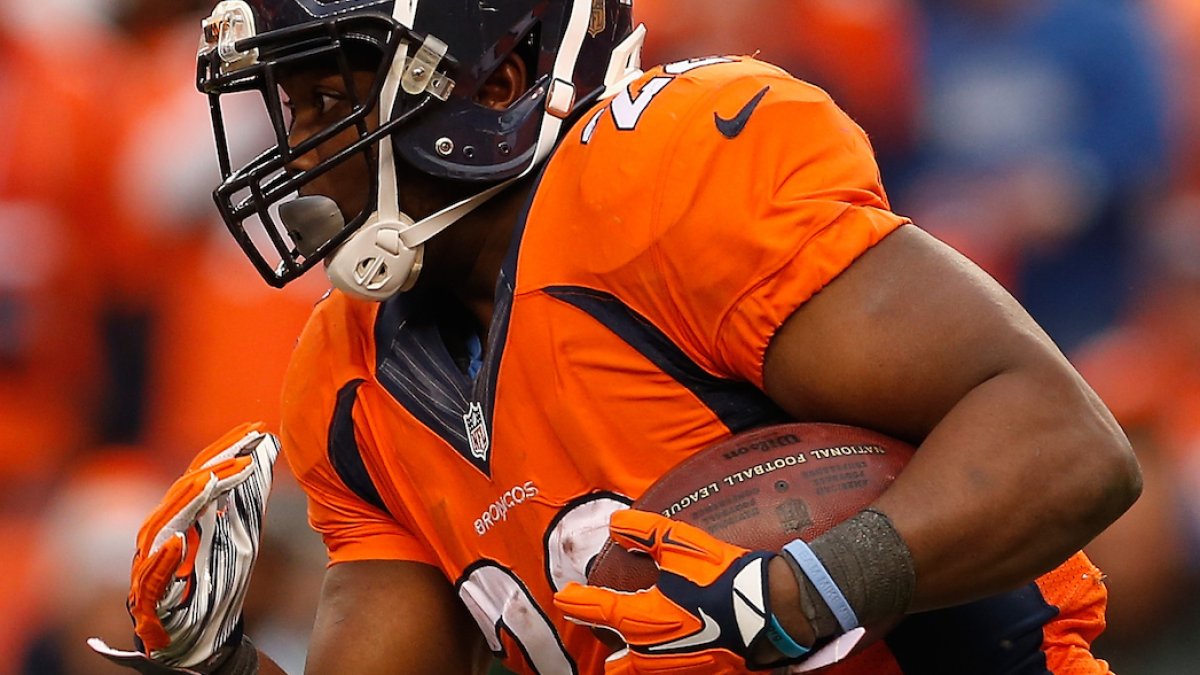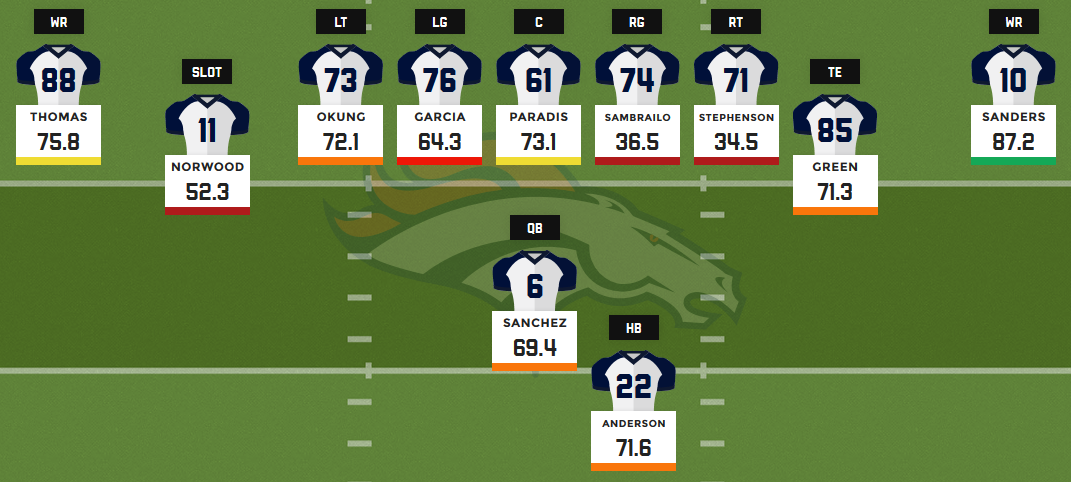(Editor’s note: As we lead up to the season, Director of PFF Fantasy Jeff Ratcliffe is breaking down each team’s depth chart from a fantasy perspective. Catch up on the work so far here.)
The defending Super Bowl champions enter the 2016 season in a rather unusual position with the potential of not having last year’s quarterback under center. With Peyton Manning riding off into the sunset and Brock Osweiler now in Houston, the starting job will likely come down to journeyman Mark Sanchez or former seventh-rounder Trevor Siemian.
A few years removed from the infamous “butt fumble,” Sanchez signed with the Broncos in the offseason after a two-year stint with the Eagles. He was given a long leash in New York, but never managed to complete more that 57 percent of his passes in his time with the Jets. Sanchez was more accurate in his two season in Philly, but he also managed an uninspiring 18 touchdowns and 15 interceptions in 12 games played.
Siemian was largely an afterthought entering the offseason, but the former Northwestern quarterback impressed in the offseason and is very much in the mix for the job. Expect a wide open competition for the starting job. Likewise, don’t expect rookie Paxton Lynch to be in contention. The rookie enters the league somewhat raw, but with an impressive college resume. Lynch threw 28 touchdowns and just four interceptions in 2015. He also completed 51.8 percent of balls over 20 yards in the air, which was fifth in the nation. He’s also capable as a runner, posting 339 yards on the ground in 2015. Despite the positives, Lynch struggled in offseason practices and will enter the year as the No. 3.
Denver Broncos projected 2016 offense with 2015 grades:
In the Manning era, we could essentially lock Demaryius Thomas in as a WR1, but that’s no longer a given in 2016. Not only is the quarterback situation extremely suspect, but Thomas is also coming off a season where he struggled, dropping 12 passes. Only Mike Evans and Amari Cooper dropped more. He was rarely targeted downfield, with just 12.4 percent of his targets coming on balls traveling 20-plus yards. That was fourth-lowest at the position. Thomas remains the top target in the Denver offense, but concerns about his quarterback and his declining play position him as a mid-range WR2.
The quarterback situation will also negatively impact Emmanuel Sanders. He’s coming off a solid season where he finished 18th in standard fantasy points and saw the 13th-most targets among wide receivers. Sanders especially excelled as a deep target for the Broncos. He ranked third in the league in deep targets with 37, catching 10 of them for 447 yards and three scores. While Sanders has proven to be a strong fantasy asset over the last two seasons, his fantasy arrow is pointing down. It’s tough to trust him as more than a WR3.
Jordan Norwood, Bennie Fowler and Cody Latimer will all be in the mix for No. 3 duties. None of these three are likely to surface on the fantasy radar. Likewise, it’s doubtful any fantasy value comes from the Denver tight ends. Jeff Heuerman and Virgil Green figure to be the primary tight ends. Heuerman missed all of last season with a torn ACL, but got a little buzz early in the offseason. Green has also received his annual offseason hype, but it’s unlikely either is a 2016 fantasy asset.
While the Denver passing game is trending down, there’s the potential for fantasy opportunity in the Broncos’ run game. Gary Kubiak likes to run the ball, and his offensive has produced strong seasons for Arian Foster and Justin Forsett. C.J. Anderson sits atop the depth chart entering camp with rookie Devontae Booker and veteran Ronnie Hillman also in the mix.
Last year, Anderson was drafted as the sixth running back off the board with an ADP of 1.08. He finished 28th in fantasy scoring. That’s not a good return on investment. So what went wrong? For starters, the Broncos had to run a hybrid version of Kubiak’s offense with Manning under center. In the 10 games Manning started, Anderson was 41st in fantasy points. In the five games he played with Osweiler, Anderson ranked 10th in fantasy scoring. He also tied for fifth in the league with 2.9 yards after contact per attempt.
[Anderson won’t go in the first round like he did a year ago. Can you get value from where he is going in drafts? Check out our PFF Draft Master tool and try a mock draft, complete with offensive line grades, full projections and all the PFF data.]
Anderson clearly excelled in the true Kubiak zone-blocking scheme, and the Broncos matched an offer sheet that Anderson signed with Miami in the offseason. However, this was before the team selected Booker in the fourth round of April’s draft. Booker graded out as our No. 3 draft-eligible running back and ranked fourth in PFF elusive rating with 71 forced missed tackles last season. Our analysts compare Booker to Arian Foster in the pre-draft process, which bodes well for his success in Kubiak’s offense. He’s likely to be ahead of Hillman for third-down duties and could eat into Anderson’s early-down work. Anderson is still an RB2, but fantasy drafters would be wise to not overlook Booker in the later rounds.
On the defensive side of the ball, the Broncos 3-4 scheme unfortunately devalues Von Miller and DeMarcus Ware. Neither player has much IDP value outside of big-play leagues. At off-ball linebacker, Brandon Marshall has proved to be one of the league’s more productive tackles in recent seasons. With Danny Trevathan now in Chicago, Marshall will have less competition for tackles and is on the fringes of the LB1 conversation. At safety, T.J. Ward has been an IDP mainstay for much of his career. He remains a viable DB2 option.



 © 2025 PFF - all rights reserved.
© 2025 PFF - all rights reserved.